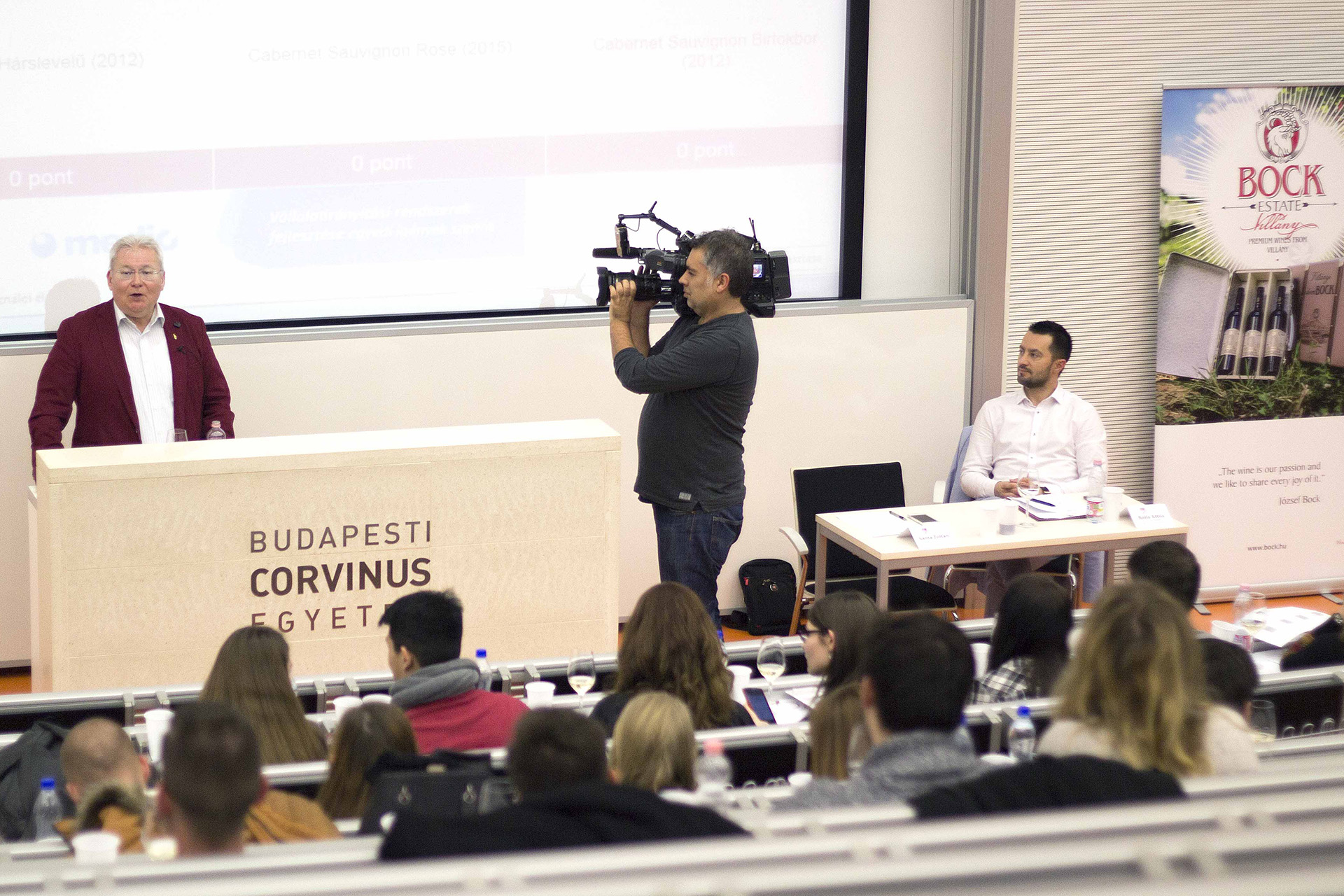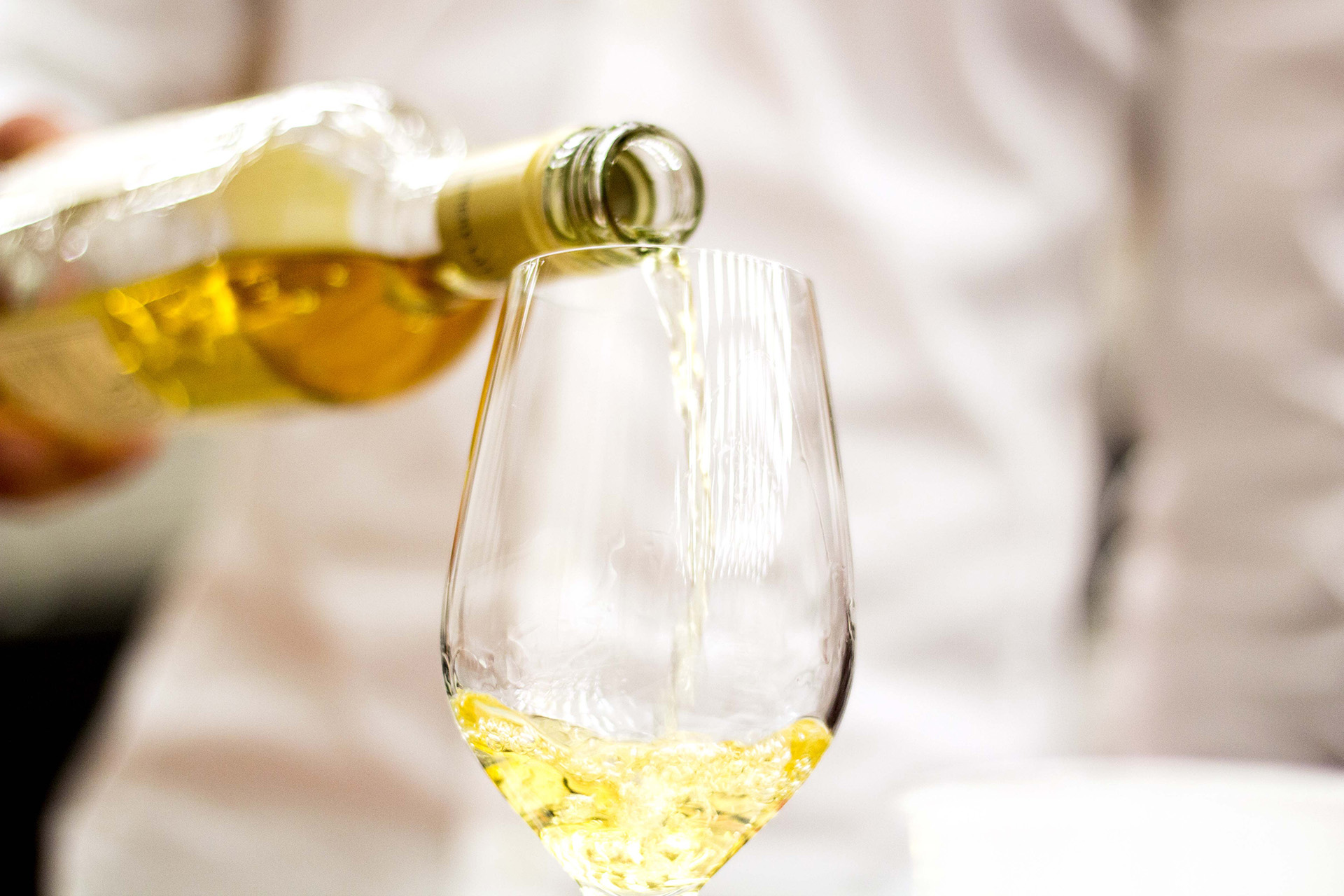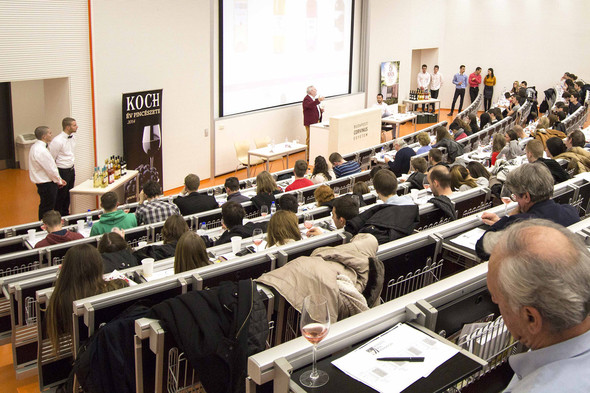This programme was launched last year in connection with a mobile wine application, ‘bortext’ allowing students to rate wines and for the results at a particular to be collated, giving an overall rating out of 100. The aim of the event was to tell students a bit more about the world of wine, explain what the National Wines of Excellence Programme was all about, show them how to taste and evaluate wine and present the wine marathon, an event that links wine with running to be held in May over a period of ten days. The event was held at the Corvinus University in Budapest on 10 December last year, but will be repeated at other universities around Hungary during the first half of this year.
The idea is to show students how to taste, rather than drink, wine, thus to educate the next generation of Hungarian wine drinkers. First of all, Zoltán Santa, representing the Borkollegium wine school, explained to participants what the plastic cup next to the wine glass was for. If the wine in the glass was too much or you didn’t like it, you could spit it out. This raised a laugh from the participating students. I suspected the cups would see little use.

First of all, Péter Gál from the Ministry of Agriculture gave a brief presentation of the National Wines of Excellence Programme (Nemzeti Borkivalóság Program), initiated in 2013 in order to help promote quality Hungarian wines. It aims to show wines from all parts of the country, both international and Hungarian grape varieties and give them a quality positioning. It is not a competition, rather a possibility for winemakers to promote themselves and for wine merchants to learn more about quality wine. It’s quite an undertaking, as they tasted 890 samples of wine over 10 days in 1500 tasting hours, of which 295 white and 185 red were rated highly enough to make it into the book. As well as running marketing promotions in Hungary, they were on the road last year promoting Hungarian wine at Prowein in Düsseldorf and in China, in Crakow and at the London Wine Fair.
Kristian Kielmayer, the Ministry of Agriculture’s wine expert, gave a brief overview of wine trends in Hungary and around the world, pointing out how the country had returned from an overemphasis on international varieties to their roots, and now more than 60% of wines produced in Hungary were from local varieties, such as Kékfrankos, Bianca, Cserszegi Fűszeres and Furmint. He remarked how the modern and traditional were now sitting side by side and many producers were now aiming for a clean and fruity style, using less oak than before (although still quite a lot). Another trend mentioned was the increase in alcohol, and the Hungarians’ taste for rosé, spritzer (fröccs) and sparkling wine, which had seen a 30% growth in the last year, as well as consumer trends such as special offers, festivals and tourisms. Hungary is still a country with many small producers, ‘hobby’ winemakers who make wine for themselves and their friends. Interestingly, he informed us, plenty of sweet red wine is still being made; well, someone must be drinking it in that case. He also stressed the need for people who can communicate about wine so that people understand it better. He then moved on to technology (and I think most of this went over the students’ heads!), climate change and the search for cooler places to cultivate vines, for example England, choice of closures, finishing with some international trends, Coravin and the need to communicate with consumers via technology and create experiences.

Now onto the part that all the students were waiting for, the tasting! Zoltán explained the difference between drinking for pleasure and tasting for knowledge, making a rather rude analogy regarding spitting out wine. Although it seems that ladies have a genetic advantage when it comes to tasting, 50% is apparently down to practice, 40% to memory, 5% luck and 5% pure bullshit. Zoltán took the students through the process of tasting. He pointed out the importance of sniffing before you swirl, and joked that he was so used to swirling his glass, he absent-mindedly found himself doing that with water too. So, it’s not only me! What can the colour indicate? Whether it’s old or young, oaked or not, where is it from, and does colour actually have taste?? For many people, it seems, yes. When tasting a white wine dyed red, 77% of people thought it was indeed red and noted down flavours more associated with red wine, so it appears the colour belies the truth. Likewise with the label, people generally rate a wine more highly if they think it is expensive. The importance of the type of glass. Where you taste different flavours, such as salty, bitter and sweet. The importance of balance, including that of acidity and tannins. The importance of the temperature at which the wine is served and how chilling more or less could help to cover up imbalances in the wine.
The students then had the chance to taste three wines, which they could rate out of 100 using the app and the group result (at least of those who had the app) came up on the screen. I noticed very little use of the plastic cups and heard several glasses smash, but the students seemed to have enjoyed themselves.
The event finished with a video about the wine marathon, which in addition to linking wine with sport, also aims to connect the wine regions with various events.






